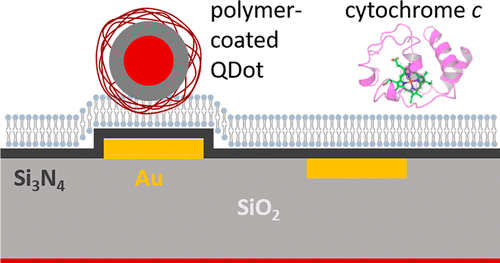Our official English website, www.x-mol.net, welcomes your
feedback! (Note: you will need to create a separate account there.)
Influence of Sensor Coating and Topography on Protein and Nanoparticle Interaction with Supported Lipid Bilayers
Langmuir ( IF 3.7 ) Pub Date : 2021-02-09 , DOI: 10.1021/acs.langmuir.0c02662 Hui Yin 1 , Arielle C Mensch 2 , Christian A Lochbaum 2 , Isabel U Foreman-Ortiz 2 , Emily R Caudill 2 , Robert J Hamers 2 , Joel A Pedersen 3
Langmuir ( IF 3.7 ) Pub Date : 2021-02-09 , DOI: 10.1021/acs.langmuir.0c02662 Hui Yin 1 , Arielle C Mensch 2 , Christian A Lochbaum 2 , Isabel U Foreman-Ortiz 2 , Emily R Caudill 2 , Robert J Hamers 2 , Joel A Pedersen 3
Affiliation

|
Supported lipid bilayers (SLBs) have proven to be valuable model systems for studying the interactions of proteins, peptides, and nanoparticles with biological membranes. The physicochemical properties (e.g., topography, coating) of the solid substrate may affect the formation and properties of supported phospholipid bilayers, and thus, subsequent interactions with biomolecules or nanoparticles. Here, we examine the influence of support coating (SiO2vs Si3N4) and topography [sensors with embedded vs protruding gold nanodisks for nanoplasmonic sensing (NPS)] on the formation and subsequent interactions of supported phospholipid bilayers with the model protein cytochrome c and with cationic polymer-wrapped quantum dots using quartz crystal microbalance with dissipation monitoring and NPS techniques. The specific protein and nanoparticle were chosen because they differ in the degree to which they penetrate the bilayer. We find that bilayer formation and subsequent non-penetrative association with cytochrome c were not significantly influenced by substrate composition or topography. In contrast, the interactions of nanoparticles with SLBs depended on the substrate composition. The substrate-dependence of nanoparticle adsorption is attributed to the more negative zeta-potential of the bilayers supported by the silica vs the silicon nitride substrate and to the penetration of the cationic polymer wrapping the nanoparticles into the bilayer. Our results indicate that the degree to which nanoscale analytes interact with SLBs may be influenced by the underlying substrate material.
中文翻译:

传感器涂层和形貌对蛋白质和纳米颗粒与脂质双分子相互作用的影响
已证明支持的脂质双层(SLB)是用于研究蛋白质,肽和纳米颗粒与生物膜相互作用的有价值的模型系统。固体基质的物理化学性质(例如,形貌,涂层)可能影响负载的磷脂双层的形成和性质,并因此影响随后与生物分子或纳米颗粒的相互作用。在这里,我们检查支持涂层的(SIO影响2 VS的Si 3 Ñ 4)和地形[传感器具有嵌入VS突出金纳米盘为纳米等离子体激元的感测(NPS)]上形成并支持磷脂双层的后续交互与模型蛋白细胞色素C以及带有阳离子聚合物包裹的量子点,使用石英晶体微天平,耗散监测和NPS技术。选择特定的蛋白质和纳米颗粒是因为它们穿透双层的程度不同。我们发现双层形成以及随后与细胞色素c的非穿透性结合不受底物组成或形貌的显着影响。相反,纳米颗粒与SLB的相互作用取决于底物组成。纳米颗粒吸附的底物相关性归因于硅胶所支撑的双层的负ζ电势与氮化硅衬底和将纳米颗粒包裹在双层中的阳离子聚合物的渗透。我们的结果表明,纳米级分析物与SLB相互作用的程度可能受到下面的底物材料的影响。
更新日期:2021-02-23
中文翻译:

传感器涂层和形貌对蛋白质和纳米颗粒与脂质双分子相互作用的影响
已证明支持的脂质双层(SLB)是用于研究蛋白质,肽和纳米颗粒与生物膜相互作用的有价值的模型系统。固体基质的物理化学性质(例如,形貌,涂层)可能影响负载的磷脂双层的形成和性质,并因此影响随后与生物分子或纳米颗粒的相互作用。在这里,我们检查支持涂层的(SIO影响2 VS的Si 3 Ñ 4)和地形[传感器具有嵌入VS突出金纳米盘为纳米等离子体激元的感测(NPS)]上形成并支持磷脂双层的后续交互与模型蛋白细胞色素C以及带有阳离子聚合物包裹的量子点,使用石英晶体微天平,耗散监测和NPS技术。选择特定的蛋白质和纳米颗粒是因为它们穿透双层的程度不同。我们发现双层形成以及随后与细胞色素c的非穿透性结合不受底物组成或形貌的显着影响。相反,纳米颗粒与SLB的相互作用取决于底物组成。纳米颗粒吸附的底物相关性归因于硅胶所支撑的双层的负ζ电势与氮化硅衬底和将纳米颗粒包裹在双层中的阳离子聚合物的渗透。我们的结果表明,纳米级分析物与SLB相互作用的程度可能受到下面的底物材料的影响。











































 京公网安备 11010802027423号
京公网安备 11010802027423号